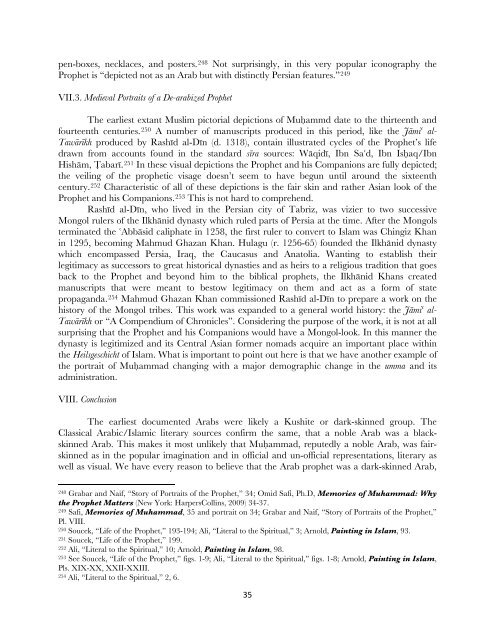“Anyone who says that the Prophet is black should be killed”: The ...
“Anyone who says that the Prophet is black should be killed”: The ...
“Anyone who says that the Prophet is black should be killed”: The ...
Create successful ePaper yourself
Turn your PDF publications into a flip-book with our unique Google optimized e-Paper software.
pen-boxes, necklaces, and posters. 248 Not surpr<strong>is</strong>ingly, in th<strong>is</strong> very popular iconography <strong>the</strong><br />
<strong>Prophet</strong> <strong>is</strong> “depicted not as an Arab but with d<strong>is</strong>tinctly Persian features.” 249<br />
VII.3. Medieval Portraits of a De-arabized <strong>Prophet</strong><br />
<strong>The</strong> earliest extant Muslim pictorial depictions of MuÈammd date to <strong>the</strong> thirteenth and<br />
fourteenth centuries. 250 A num<strong>be</strong>r of manuscripts produced in th<strong>is</strong> period, like <strong>the</strong> J§mi# al-<br />
Taw§rÊkh produced by RashÊd al-DÊn (d. 1318), contain illustrated cycles of <strong>the</strong> <strong>Prophet</strong>’s life<br />
drawn from accounts found in <strong>the</strong> standard sÊra sources: W§qidÊ, Ibn Sa#d, Ibn IsÈaq/Ibn<br />
H<strong>is</strong>h§m, •abarÊ. 251 In <strong>the</strong>se v<strong>is</strong>ual depictions <strong>the</strong> <strong>Prophet</strong> and h<strong>is</strong> Companions are fully depicted;<br />
<strong>the</strong> veiling of <strong>the</strong> prophetic v<strong>is</strong>age doesn’t seem to have <strong>be</strong>gun until around <strong>the</strong> sixteenth<br />
century. 252 Character<strong>is</strong>tic of all of <strong>the</strong>se depictions <strong>is</strong> <strong>the</strong> fair skin and ra<strong>the</strong>r Asian look of <strong>the</strong><br />
<strong>Prophet</strong> and h<strong>is</strong> Companions. 253 Th<strong>is</strong> <strong>is</strong> not hard to comprehend.<br />
RashÊd al-DÊn, <strong>who</strong> lived in <strong>the</strong> Persian city of Tabriz, was vizier to two successive<br />
Mongol rulers of <strong>the</strong> Ilkh§nid dynasty which ruled parts of Persia at <strong>the</strong> time. After <strong>the</strong> Mongols<br />
terminated <strong>the</strong> #Abb§sid caliphate in 1258, <strong>the</strong> first ruler to convert to Islam was Chingiz Khan<br />
in 1295, <strong>be</strong>coming Mahmud Ghazan Khan. Hulagu (r. 1256-65) founded <strong>the</strong> Ilkh§nid dynasty<br />
which encompassed Persia, Iraq, <strong>the</strong> Caucasus and Anatolia. Wanting to establ<strong>is</strong>h <strong>the</strong>ir<br />
legitimacy as successors to great h<strong>is</strong>torical dynasties and as heirs to a religious tradition <strong>that</strong> goes<br />
back to <strong>the</strong> <strong>Prophet</strong> and <strong>be</strong>yond him to <strong>the</strong> biblical prophets, <strong>the</strong> Ilkh§nid Khans created<br />
manuscripts <strong>that</strong> were meant to <strong>be</strong>stow legitimacy on <strong>the</strong>m and act as a form of state<br />
propaganda. 254 Mahmud Ghazan Khan comm<strong>is</strong>sioned RashÊd al-DÊn to prepare a work on <strong>the</strong><br />
h<strong>is</strong>tory of <strong>the</strong> Mongol tri<strong>be</strong>s. Th<strong>is</strong> work was expanded to a general world h<strong>is</strong>tory: <strong>the</strong> J§mi# al-<br />
Taw§rÊkh or “A Compendium of Chronicles”. Considering <strong>the</strong> purpose of <strong>the</strong> work, it <strong>is</strong> not at all<br />
surpr<strong>is</strong>ing <strong>that</strong> <strong>the</strong> <strong>Prophet</strong> and h<strong>is</strong> Companions would have a Mongol-look. In th<strong>is</strong> manner <strong>the</strong><br />
dynasty <strong>is</strong> legitimized and its Central Asian former nomads acquire an important place within<br />
<strong>the</strong> Heilsgeschicht of Islam. What <strong>is</strong> important to point out here <strong>is</strong> <strong>that</strong> we have ano<strong>the</strong>r example of<br />
<strong>the</strong> portrait of MuÈammad changing with a major demographic change in <strong>the</strong> umma and its<br />
admin<strong>is</strong>tration.<br />
VIII. Conclusion<br />
<strong>The</strong> earliest documented Arabs were likely a Kushite or dark-skinned group. <strong>The</strong><br />
Classical Arabic/Islamic literary sources confirm <strong>the</strong> same, <strong>that</strong> a noble Arab was a <strong>black</strong>skinned<br />
Arab. Th<strong>is</strong> makes it most unlikely <strong>that</strong> MuÈammad, reputedly a noble Arab, was fairskinned<br />
as in <strong>the</strong> popular imagination and in official and un-official representations, literary as<br />
well as v<strong>is</strong>ual. We have every reason to <strong>be</strong>lieve <strong>that</strong> <strong>the</strong> Arab prophet was a dark-skinned Arab,<br />
248 Grabar and Naif, “Story of Portraits of <strong>the</strong> <strong>Prophet</strong>,” 34; Omid Safi, Ph.D, Memories of Muhammad: Why<br />
<strong>the</strong> <strong>Prophet</strong> Matters (New York: HarpersCollins, 2009) 34-37.<br />
249 Safi, Memories of Muhammad, 35 and portrait on 34; Grabar and Naif, “Story of Portraits of <strong>the</strong> <strong>Prophet</strong>,”<br />
Pl. VIII.<br />
250 Soucek, “Life of <strong>the</strong> <strong>Prophet</strong>,” 193-194; Ali, “Literal to <strong>the</strong> Spiritual,” 3; Arnold, Painting in Islam, 93.<br />
251 Soucek, “Life of <strong>the</strong> <strong>Prophet</strong>,” 199.<br />
252 Ali, “Literal to <strong>the</strong> Spiritual,” 10; Arnold, Painting in Islam, 98.<br />
253 See Soucek, “Life of <strong>the</strong> <strong>Prophet</strong>,” figs. 1-9; Ali, “Literal to <strong>the</strong> Spiritual,” figs. 1-8; Arnold, Painting in Islam,<br />
Pls. XIX-XX, XXII-XXIII.<br />
254 Ali, “Literal to <strong>the</strong> Spiritual,” 2, 6.<br />
35
















